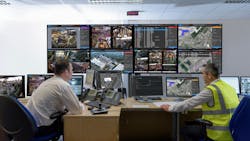Real-Time Crime Centers: Do (Much) More With Less
By Phil Malencsik Account Executive, Public Sector at Genetec
As cities evolve to adapt to rapid changes in global technology, infrastructure, and populations, the scope and level of crime is also changing, making it tougher than ever before to police urban centers. In addition, the number of law enforcement professionals around the world is dropping. Statista reports that there was one police officer for every 500 U.S. residents in 2021, compared to one for every 433 residents in 2009.
Faced with shrinking resources, and a changing crime landscape, police departments still have to keep on top of events as they happen and find ways to respond faster in emergency situations. To remain efficient at reducing crime and maintain public safety, police departments need to evolve too.Cities around the world have invested in technology to help support the efforts of police departments with more cameras, sensors, and data sources than ever before. A widely-cited IHS Markit survey estimated that there were 1 billion surveillance cameras installed worldwide at the end of 2021. And while this digital transformation seems like it should be helping, police departments often describe themselves as “data rich but information poor”. Faced with multiple, unconnected systems (surveillance video, ALPR data, Computer Aided Dispatch (CAD) systems, gunshot detection, and more), police departments can become overwhelmed by the sheer amount of unconnected data at their disposal, placing an additional burden on their already stretched time and resources. Disorganized and siloed data inhibits collaboration across teams and slows down incident response times.
Real-time crime centers (RTCC) have emerged as a cost-effective, efficient technology to increase public safety. They are helping police departments increase situational awareness and officer safety and solve cases faster—all with fewer resources.
How real-time crime centers help reduce crime and keep officers safe
Designed to support the efforts of local police departments of big and small cities, RTCCs are crime-fighting nerve centers that facilitate decision-making through increased intelligence and better understanding. They are based on a unified platform that centralizes a broad range of technologies, helping coordinate public safety personnel so they can respond to situations quickly and efficiently and direct their attention to active crimes in progress, high-crime areas, or large-scale public events that may require law enforcement presence.
By streaming information from various sensors across the city, RTCCs provide access to security footage from live video surveillance feeds (VMS), license plate details from license plate recognition tools (ALPR), and third-party applications like gunshot detection alerts, computer-aided dispatch calls, sensors, offender criminal history databases and more. Their revolutionary aspect is their ability to unify data streams and operations across city departments, present the data in meaningful ways (such as on maps), and disseminate timely information to law enforcement. Essentially, a RTCC gives law enforcement personnel the benefit of seeing everything at once through a single pane of glass.
This shared data capability helps cities break down siloes between departments and even collaborate more effectively with the community, to increase public safety. It enables police to respond more quickly, and with better situational awareness to keep them safe. And it aids in investigations, helping to solve cases faster and manage evidence more efficiently.
In addition to streamlining response protocols, RTCC teams can also access historical video, information, and events to help strengthen investigations and keep department leads and decision-makers informed.
RTCCs are proving to be effective in reducing crime. In 2019, a RAND Corporation study quantified the positive impact of an RTCC based on Genetec CitigrafTM in Chicago; a five to 15 percent average reduction in crime, with some districts reaching up to a 40 percent reduction in certain illicit actions. The study proposed that a district adding an RTCC can expect to see reductions in at least some of the 10 types of major crimes modeled, including shootings, robbery, burglary, and criminal sexual assault.
The pillars of RTCCs: Unification and federation
How does a RTCC differ from a traditional operations center? In the traditional model, data from CAD, VMS, ALPR, body worn cameras (BWC), and other sources is siloed in standalone systems across city departments—often in different buildings. Without central organization, teams can’t collaborate easily. When a call comes in reporting a robbery in progress, or a sensor alerts them to gunshots in a particular area, staff have to consult one source to locate the closest cameras, and another to locate the nearest gunshot detector. They run back and forth between buildings. They may locate the sources they need only to find that cameras are offline and didn’t capture anything useful. Or they might have to travel to a local business to request (and wait for) video from their surveillance camera. Gathering data takes time, which delays response and/or sends officers to the scene with little situational awareness.
The first step in developing a RTCC is to unify and centralize public safety operations and develop a common operating picture. Doing this means shifting from standalone, isolated systems to an open, unified platform that consolidates data streams across city departments. A strategic decision support system that facilitates collaboration and connectivity between multiple systems from CAD to VMS, ALPR, record management, and more, is the foundation of the solution.
Data is presented using map-based visualization, giving law enforcement a consolidated view of what’s happening in the city. Law enforcement can then prioritize and coordinate officer interventions and responses to better protect citizens and make informed decisions. These systems also continually monitor the health of all connected sensors and cameras, so they can be checked and serviced proactively.
The other pillar of RTCCs is federation. A federated city is one in which multiple entities (Police, Fire, EMS, city managers, businesses, community leaders, etc.) partner in a meaningful way to achieve a common purpose regarding urban security. More than a network, partnerships that are federated enable stakeholders to enhance the capacity of each other to prepare, respond, and investigate. In the context of a RTCC, federation can be achieved with technology that allows agencies to consolidate live monitoring, video searches, alarm management, and health reporting from many independent sites. Publicly and privately-owned and operated agencies can share vital information through federation while maintaining strict rights and privileges that allow them to remain in compliance with the connected systems and with personal privacy regulations.
One example of how this works is a partnership the City of New Orleans Sanitation department, in the United States, built with its RTCC to catch illegal dumping in real time. They installed cameras at known sites and worked with the IT department at the RTCC to set up an event-to-action rule in their system to process motion detection in a defined zone of the cameras’ field of view, automatically capture an image from the video, and alert specific people in the Sanitation department via email. The program enabled the Department to provide evidence of illegal dumping and identify perpetrators for arrests and investigation.
----
As crime rates and community expectations rise, public safety agencies must do more than react to situations in progress. Real-time crime centers unify the data, surveillance, and intelligence needed to address situations at the point of crisis. Automating and centralizing this data saves valuable time for police departments, enabling them to do much more with fewer officers.
Today, more than 85 cities have deployed RTCC to help the move towards modern policing, reduce police response time, save public safety hours, and improve situational awareness dramatically.

